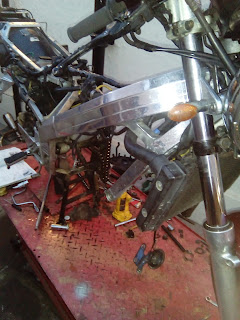We eventually got bored of oiling up plugs and having to push it home. So we bought a 650 top end rebuild kit a 650 CDI unit and rev counter off of ebay and got to work taking the old 400 motor out.
This wasn't easy we did away with the manual and simply loosened everything, we got a bit caught out when it didnt budge. Thankfully we saw that there were adjusting screws in the frame still clamping it in place. I was really impressed with just how much engineering had gone into the motor mounts at the back. Its worth mentioning that I had previously purchased the castleated nut required to loosen the lock nut off of the swinging arm bolt.
We managed to get the motor out without braking the chain.
These are the barrels off of my 650 lump, the honing marks were still in tact and there weren't any obvious signs of blowing. So we decided to keep costs down just to clean and rebuild the top end with fresh gaskets.
The barrels and the whole engine suffered from flaking paint, I couldn't be arsed with the bottom end but I thought I would take a wire brush and sand down the barrels for painting. The barrels had some bits of the old head gaskets, to get this off I glued some 1000 grit paper onto a MDF board and scraped a small amount of material off to clean up the top surfaces. I used plenty of water. I was really pleased the with smooth and shiny surface finish afterwards.
I used two colours of engine paint, grey UHT for a primer and a silver caliper paint for the top coat, both were made by Nycott. I will postup pictures of he barrels after they have been on a good run to see if the paint is up to the job.
Time for rebuild, I poured a load of oil down past the piston skirts with the sump plug off to help flush out any shit that had made its way down there. Its not perfect but it will have to do. I will also be giving this engine a couple of rapid oil changes to help flush out any dirt that may have found its way into the bottom end. You can never change the oil too much on a motor. And yes filters will be replaced with the oil obvs. Its worth mentioning that I used two spare heads I'vehad lying around instead of the originals, reason being they have been skimmed and ported, plus they have new stem seals, I reground the valves just to ensure maximum compression will be achieved. This bike should perform well.
Made my first cock up of many! This part in my hand is a cam chain guard, it sits on the other side to the tensioner, its sits between the head and barrels. I only noticed it once I had torqued the cylinder head down and dialed in the cam. So yeah thats the last time ill ever do that.
This is a neat tip the manual recommends putting a 2mm pin of some sort in the cam chain tensioner as seen above to lock it in place. I would recommend doing this outside of the engine, clamp one part in a vice and then pull the sliding part down to reveal the hole and slot in the rivet or pin. This is a true paint to do in the engine, but a piece of cake in a vice. Also make sure you copy this picture exactly, if your pin is on the other side you wont have clearance to fit the cam shaft gear when rebuilding.
Finally all together after dialing in both cams and checking that the engine rotates by hand, next step is to drop in some new plugs, this bike is also getting some new Honda coils, because bike parts.
After realising im too much of a weed to lift the engine in the frame and locate the bolts I bought a 2 tonne car jack from halfords. A tip would be to loosen all of the engine bolts adjusters all the way out and bring them in when the bolts are taking the motor's weight.












































